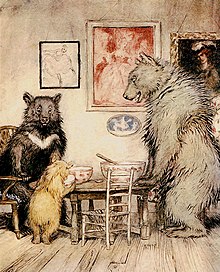
Back غولديلوكس والدببة الثلاثة Arabic An tri arzh Breton Виҫӗ упа CV Goldlöckchen und die drei Bären German La tri ursoj Esperanto Ricitos de Oro y los tres osos Spanish گلدیلاکس و سه خرس Persian Kultakutri ja kolme karhua Finnish Boucle d'or et les Trois Ours French זהבה ושלושת הדובים HE
You can help expand this article with text translated from the corresponding article in German. (May 2024) Click [show] for important translation instructions.
|
| "Goldilocks and The Three Bears" | |
|---|---|
| Short story by Robert Southey | |
 Illustration by Arthur Rackham, 1918, in English Fairy Tales by Flora Annie Steel | |
| Original title | "The Story of the Three Bears" |
| Country | England |
| Genre(s) | Fairy tale |
| Publication | |
| Published in | The Doctor |
| Publication type | Essay and story collection |
| Publisher | Longman, Rees, etc. |
| Media type | |
| Publication date | 1837 |
"Goldilocks and the Three Bears" is a 19th-century English fairy tale of which three versions exist. The original version of the tale tells of an impudent old woman who enters the forest home of three anthropomorphic bachelor bears while they are away. She eats some of their porridge, sits down on one of their chairs, breaks it, and sleeps in one of their beds. When the bears return and discover her, she wakes up, jumps out of the window, and is never seen again. The second version replaces the old woman with a young, naive, blonde-haired girl named Goldilocks, and the third and by far best-known version replaces the bachelor trio with a family of three. The story has elicited various interpretations and has been adapted to film, opera, and other media. "Goldilocks and the Three Bears" is one of the most popular fairy tales in the English language.[1]

- ^ Elms 1977, p. 257
© MMXXIII Rich X Search. We shall prevail. All rights reserved. Rich X Search